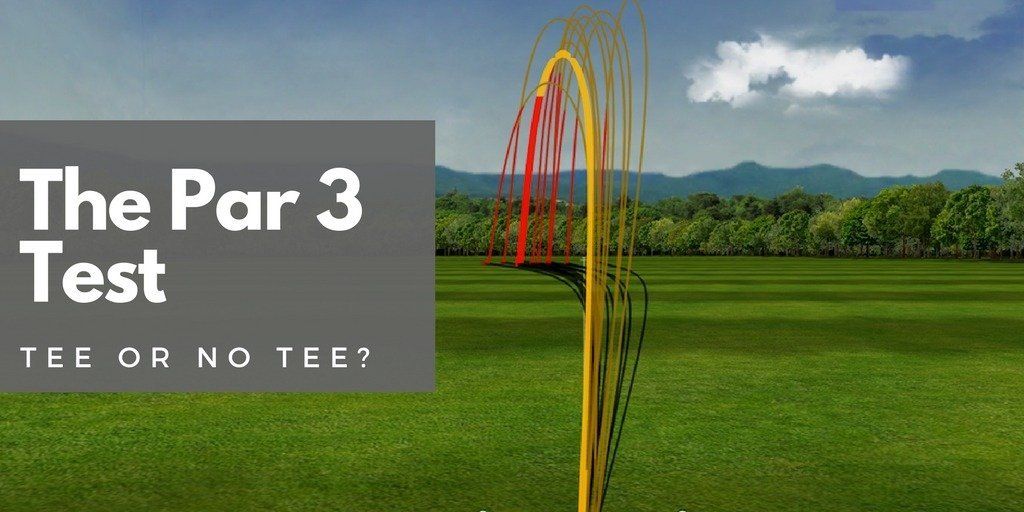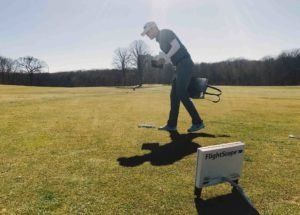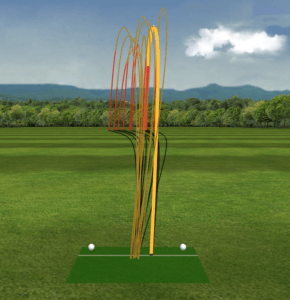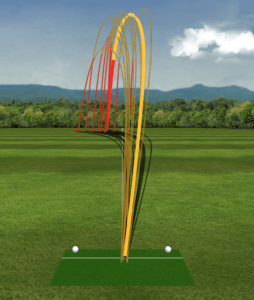
Years ago I decided to stop teeing up my ball on par 3s with my irons because I felt that it gave me a better chance at hitting an accurate shot. Whether or not it was actually true, I believed that when I teed the ball up it made the dispersion of my shots a bit wider.
Recently I put this theory to the test because I thought it was an interesting topic to explore.
The conventional wisdom is to tee your ball up on a par 3 with your irons. The point of this article is not to dispute that advice because I think it’s sound logic for most of you reading this, but rather to explore an alternative strategy that some players may benefit from.
I conducted this mini poll on Twitter, and it was not a surprise that the overwhelming majority of responses were people who did tee up the ball.
Do you tee up your ball on a par 3?
— Jon Sherman (@practicalgolf) March 1, 2017
My Theory
When I think about improving as a golfer I see an image of two lines, which represent shot dispersion. I believe every golfer should be moving from the image on the left to the image on the right.

Anything you can do to keep that ball closer to your intended target is going to help you lower your scores (and yes hitting the ball farther is part of that).
For years I noticed that when I teed the ball up with my irons my dispersion seemed to increase, but mainly on my poor shots. If I pushed it, pulled it, sliced it, or hooked it…well it seemed to do more of that, and go further to the left or right than normal.
If it was a well-struck shot, then it was heading towards my target no matter what.
Since I am someone who thinks pretty deeply about strategy on the course, I decided to stop teeing the ball up in order to keep my less-than perfect shots closer to the target. Golf is a game of proximity; the closer you are to the hole the better your chances are of scoring better on each hole.
The Test
I wanted to find out if there was any truth to this theory as it pertained to my own game (and potentially yours).
So I went out to St. Georges Country Club with my friend and PGA Professional Nick Banks on an abnormally warm and windy winter day. We were treated to 70 degree weather in the middle of February, and it was perfect conditions to try out my “teeing it up or not” theory.

Here were the parameters of the test:
- I hit 10 shots with my 7-iron on the ground, and then 10 shots with the ball teed up to a height that I felt was appropriate
- All shots were hit into about a 20-25 mph headwind, which as you may know requires a solid strike to achieve success (and a good test of accuracy)
- I used the same exact ball every time (Titleist Pro V1)
- We used a Flightscope Radar to measure my results, and I was most concerned with my carry distance and how far offline each shot was from the target
The Results
After conducting the test we took the average of 10 shots and compared them, and I found the results to be pretty interesting.
The wind was ripping pretty hard that day, and it was easily about a 1½ - 2 club differential, which meant that any shots I didn’t hit well were going to travel farther off line than in calm conditions.

My shots with the 7-iron off the ground traveled on average 156.8 yards in the air, and about 3.6 yards off the target line to the left with an average spin rate of 6548 rpms. Overall, not bad for the conditions since I typically fly a 7-iron about 170 yards on the golf course.
The teed-up shots went on average 158 yards in the air, 9.7 yards offline to the left, and had an average spin of 6979 rpms.
What was interesting was that I didn’t gain much distance at all, the ball spun a bit more, but most importantly it went 6 yards more to the left than the shots that I hit off the ground.
Here are some graphical representations of my shot dispersion as well - you can see the 7-iron off the ground was more evenly dispersed around the target line than the ones off the tee
7-iron off the ground:

7-iron off the tee:

A Little Analysis
I was not surprised by the results because it had been a pattern I had noticed on the course.
What did surprise me the most was that I really didn’t gain much distance from the ball being teed up. I only gained 1.2 yards on average, but lost just over 6 yards of accuracy. On a par three that could easily be the difference of hitting the green or not.
For me personally it confirmed my suspicion that choosing to hit the ball off the ground on a par three might be a better decision if I am mostly concerned about accuracy.
Should You Tee Your Irons Up on a Par 3?
I am absolutely not recommending that you stop using tees on a par 3. Now that I’ve gotten that out of the way let me tell you why.
For most golfers I believe that teeing the ball up gives you the best chance of making proper contact with the ball, which is ultimately the most important thing for consistency. Why give up that advantage on a par 3?
What I would tell you is to make sure you find the right tee height for your swing. Some golfers either tee it up way too high or too low. You can figure the right tee height on your own by using a dry-erase marker and experimenting with different tee heights to see where you are making contact on the face of the club.
Had I performed this test with a much wider range of golfers with varying ball striking abilities, I would suspect that lesser-skilled golfers would struggle to produce the distance and accuracy to hit more greens without using a tee.
However, for a more skilled ball striker, I do think these results are interesting. It might warrant some testing on your own to find out if it makes sense to possibly not use a tee in order to gain accuracy. I’m just one player, and this test was hardly scientific, but I’m sure some of you reading this have thought about this before.
I would file the results somewhere under, “interesting, but not definitive.”
We care about the protection of your data Read our Privacy Policy